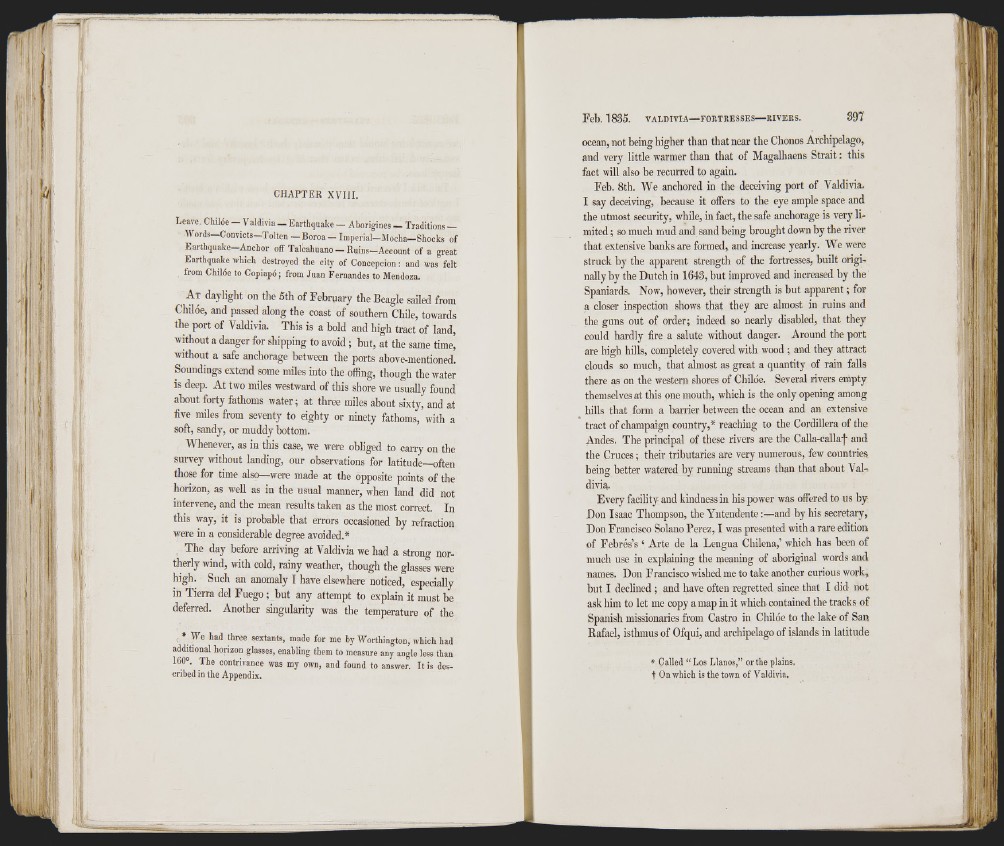
i i,
i
CHAPTER XVIil.
Leave. Chilóe — V aldivia — Earthquake — Aborigines — Traditions —
Words—Convicts-Tolten-Boroa-Imperial-Mocha-Shocks of
Earthquake—Anchor off Talcahuano — Ruins—Account of a great
Earthquake which destroyed the city of Concepcion: and was felt
from Chilóe to Copiapó; from Juan Fernandes to Mendoza.
A t daylight on the 5th of February the Beagle sailed from
Chilóe, and passed along the coast of southern Chile, towards
the port of Valdivia. This is a bold and high tract of land,
without a danger for shipping to avoid ; but, at the same time,
without a safe anchorage between the ports above-mentioned.
Soundings extend some miles into the offing, though the water
is deep. At two miles westward of this shore we usually found
about forty fathoms water; at three miles about sixty, and at
five miles from seventy to eighty or ninety fathoms, with a
soft, sandy, or muddy bottom.
Whenever, as in this case, we were obliged to carry on the
survey without landing, our observations for latitude—often
those for time also—were made at the opposite points of the
horizon, as well as in the usual manner, when land did not
intervene, and the mean results taken as the most correct. In
this way, it is probable that errors occasioned by refraction
were in a considerable degree avoided.*
The day before arriving at Valdivia we had a strong northerly
wind, with cold, rainy weather, though the glasses were
high. Such an anomaly I have elsewhere noticed, especially
in Tierra del Fuego; but any attempt to explain it must be
deferred. Another singularity was the temperature of the
• We had three sextants, made for me by Worthington, which had
additional horizon glasses, enabling them to measure any angle less than
160°. The contrivance vvas my own, and found to answer. It is described
in the Appendix.
ocean, not being higher than that near the Chonos Archipelago,
and very little warmer than that of Magalhaens Strait: this
fact will also be recurred to again.
Feb. 8th. We anchored in the deceiving port of Valdivia.
I say deceiving, because it offers to the eye ample space and
the utmost security, while, in fact, the safe anchorage is very limited
; so much mud and sand being brought down by the river
that extensive banks are formed, and increase yearly. We were
struck by the apparent strength of tire fortresses, built originally
by the Dutch in 1643, hut improved and increased by the
Spaniards. Now, however, their strength is but apparent; for
a closer inspection shows that they are almost in ruins and
the guns out of order; indeed so nearly disabled, that they
could hardly fire a salute without danger. Around the port
are high hills, completely covered with wood ; and they attract
clouds so much, that almost as great a quantity of rain falls
there as on the western shores of Chiloe. Several rivers empty
themselves at this one mouth, which is the only opening among
hills that form a barrier between the ocean and an extensive
tract of champaign country,* reaching to the Cordillera of the
Andes. The principal of these rivers are the Calla-callaf and
the Cruces; their tributaries are very numerous, few countries
being better watered by running streams than that about Valdivia.
Fvery facility and kindness in his power was offered to us by
Don Isaac Thompson, the Yntendente:—and by his secretary,
Don Francisco Solano Perez, I was presented with a rare edition
of Febrés’s ‘ Arte de la Lengua Chilena,’ which has been of
much use in explaining the meaning of aboriginal words and
names. Don Francisco wished me to take another curious work,
but I declined ; and have often regretted since that I did not
ask him to let me copy a map in it which contained the tracks of
Spanish missionaries from Castro in Chilóe to the lake of San
Rafael, isthmus of Ofqui, and archipelago of islands in latitude
* CaUed “ Los Llanos,” or the plains.
t On which is the town of Valdivia.